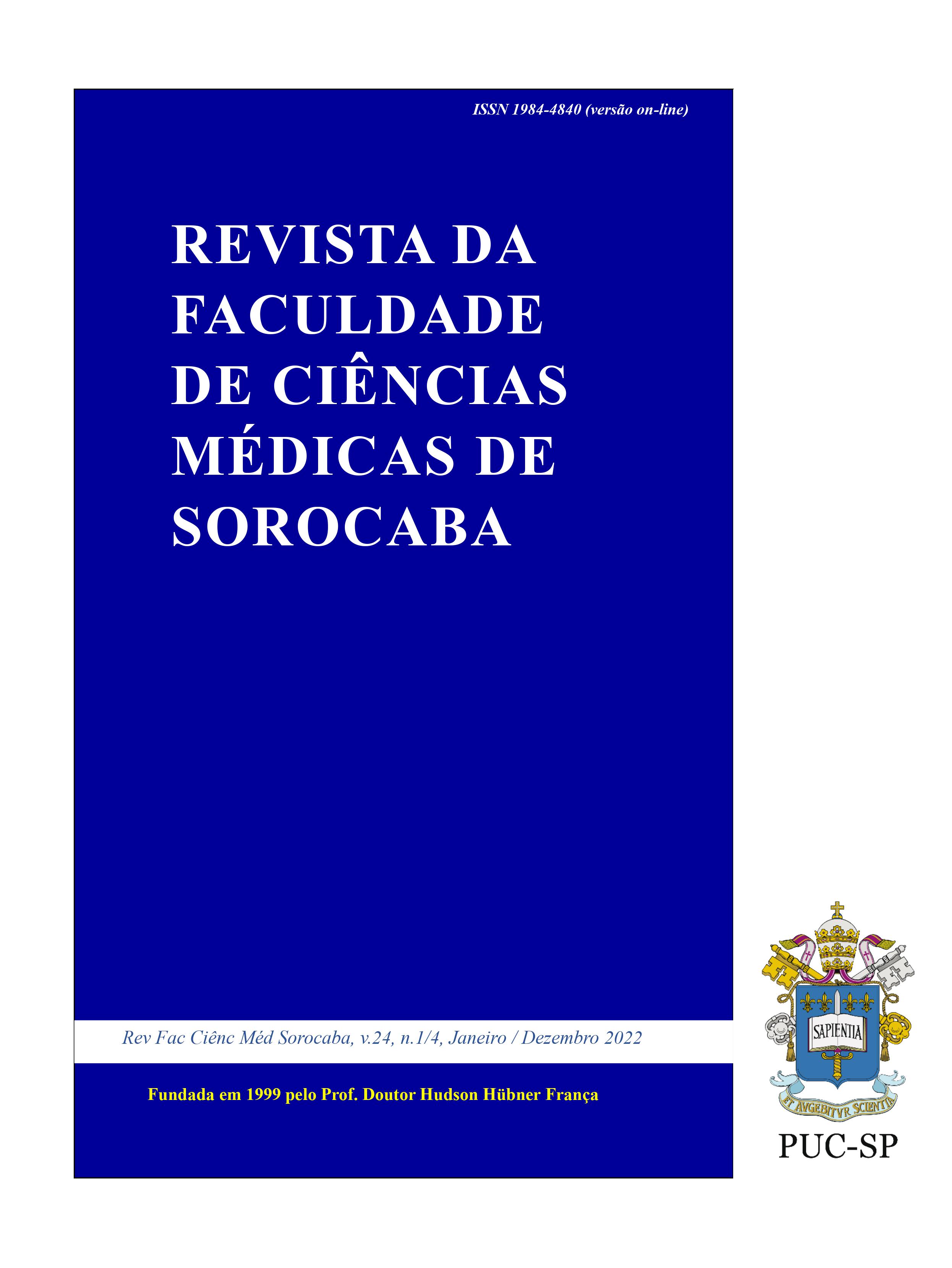Effect of prone posture in the management of non-intubated patients with acute respiratory failure caused by SARS-CoV-2
retrospective study
DOI:
https://doi.org/10.23925/1984-4840.2022v24i1/4a6Keywords:
prone position, COVID-19, SARS-CoV-2, length of stay, APACHEAbstract
The SARS-CoV-2 pandemic, more known as COVID-19, has brought some big challenges to the multiprofessional team regarding these patients. Having the potential to aggravate, this desease can acute respiratory distress syndrome (ARDS). Some conditions that may influence the risk of severity of the disease are advanced age, comorbidities and male sex. Studies reported that the prone position is used to treat hypoxemic acute respiratory failure in non-intubated patients with COVID-19, acting through gas exchange. Studies show the need to identificate subpopulations of patients with ARDS due to COVID-19 that may benefit from the active prone position. Objective: the aim of this study was to verify the effects of the active prone position and its relation with gender, comorbidities, age, pulmonary impairment, APACHE score and length of stay in the ICU. Method: This is a retrospective cross sectional observational study, performed through analysis of medical records. The patients were classified according to wether or not they performed the active prone position during the ICU stay. Result: There is a significant difference between the gender frequency distribution in the two groups (p=0.019). The group that performed the active prone position was mostly composed by patients of the male gender (70%). There is a significant difference between the APACHE scores in the two groups (p=0.03). There is a significant difference between the length of stay in the ICU between the groups (p=0.04). No patient was intubated or died. Conclusion: The active prone position can be a safe and feasible procedure.
References
Flynn Makic MB. Prone position of patients with COVID-19 and acute respiratory distress syndrome. J Perianesth Nurs. 2020;35(4):437-8. doi: 10.1016/j.jopan.2020.05.008.
Ghelichkhani P, Esmaeili M. Prone position in management of COVID-19 patients; a commentary. Arch Acad Emerg Med. 2020;8(1):e48.
Bienvenu LA, Noonan J, Wang X, Peter K. Higher mortality of COVID-19 in males: sex differences in immune response and cardiovascular comorbidities. Cardiovasc Res. 2020;116(14):2197-206. doi: 10.1093/cvr/cvaa284.
Gao YD, Ding M, Dong X, Zhang JJ, Kursat Azkur A, Azkur D, et al. Risk factors for severe and critically ill COVID-19 patients: A review. Allergy. 2021;76(2):428-55. doi: 10.1111/all.14657.
Li X, Xu S, Yu M, Wang K, Tao Y, Zhou Y, et al. Risk factors for severity and mortality in adult COVID-19 inpatients in Wuhan. J Allergy Clin Immunol. 2020;146(1):110-8. doi: 10.1016/j.jaci.2020.04.006.
Telias I, Katira BH, Brochard L. Is the prone position helpful during spontaneous breathing in patients with COVID-19? JAMA. 2020;323(22):2265-7. doi:10.1001/jama.2020.8539.
Dhont S, Derom E, Van Braeckel E, Depuydt P, Lambrecht BN. The pathophysiology of 'happy' hypoxemia in COVID-19. Respir Res. 2020;21(1):198. doi: 10.1186/s12931-020-01462-5.
Niewiński G, Starczewska M, Kański A. Prognostic scoring systems for mortality in intensive care units--the APACHE model. Anaesthesiol Intensive Ther. 2014;46(1):46-9. doi: 10.5603/AIT.2014.0010.
Yao Q, Wang P, Wang X, Qie G, Meng M, Tong X, et al. A retrospective study of risk factors for severe acute respiratory syndrome coronavirus 2 infections in hospitalized adult patients. Pol Arch Intern Med. 2020;130(5):390-9. doi: 10.20452/pamw.15312.
Knaus WA, Draper EA, Wagner DP, Zimmerman JE. APACHE II: a severity of disease classification system. Crit Care Med. 1985;13(10):818-29.
Zang X, Wang Q, Zhou H, Liu S, Xue X; COVID-19 Early Prone Position Study Group. Efficacy of early prone position for COVID-19 patients with severe hypoxia: a single-center prospective cohort study. Intensive Care Med. 2020;46(10):1927-9. doi: 10.1007/s00134-020-06182-4.
Qadri SK, Ng P, Toh TSW, Loh SW, Tan HL, Lin CB, et al. Critically Ill patients with COVID-19: a narrative review on prone position. Pulm Ther. 2020;6(2):233-46. doi: 10.1007/s41030-020-00135-4.
Bloomfield R, Noble DW, Sudlow A. Prone position for acute respiratory failure in adults. Cochrane Database Syst Rev. 2015;2015(11):CD008095. doi: 10.1002/14651858.CD008095.pub2.
Paul V, Patel S, Royse M, Odish M, Malhotra A, Koenig S. Proning in non-intubated (PINI) in times of COVID-19: case series and a review. J Intensive Care Med. 2020;35(8):818-24. doi: 10.1177/0885066620934801.
Ferrando C, Mellado-Artigas R, Gea A, Arruti E, Aldecoa C, Adalia R, et al. COVID-19 Spanish ICU Network. Awake prone positioning does not reduce the risk of intubation in COVID-19 treated with high-flow nasal oxygen therapy: a multicenter, adjusted cohort study. Crit Care. 2020;24(1):597. doi: 10.1186/s13054-020-03314-6.
Pijls BG, Jolani S, Atherley A, Derckx RT, Dijkstra JIR, Franssen GHL, et al. Demographic risk factors for COVID-19 infection, severity, ICU admission and death: a meta-analysis of 59 studies. BMJ Open. 2021;11(1):e044640. doi: 10.1136/bmjopen-2020-044640.
Ehrmann S, Li J, Ibarra-Estrada M, Perez Y, Pavlov I, McNicholas B, et al. Awake Prone Positioning Meta-Trial Group. Awake prone positioning for COVID-19 acute hypoxaemic respiratory failure: a randomised, controlled, multinational, open-label meta-trial. Lancet Respir Med. 2021;S2213-2600(21)00356-8. doi: 10.1016/S2213-2600(21)00356-8.
Pavlov I, He H, McNicholas B, Perez Y, Tavernier E, Trump MW, et al. Awake prone positioning in non-intubated patients with acute hypoxemic respiratory failure due to COVID-19. Respir Care. 2021;respcare.09191. doi: 10.4187/respcare.09191.
Downloads
Published
How to Cite
License
Copyright (c) 2023 Revista da Faculdade de Ciências Médicas de Sorocaba

This work is licensed under a Creative Commons Attribution-NonCommercial 4.0 International License.
Os autores no momento da submissão transferem os direitos autorais, assim, os manuscritos publicados passam a ser propriedade da revista.
O conteúdo do periódico está licenciado sob uma Licença Creative Commons 4.0, esta licença permite o livre acesso imediato ao trabalho e que qualquer usuário leia, baixe, copie, distribua, imprima, pesquise ou vincule aos textos completos dos artigos, rastreando-os para indexação, passá-los como dados para o software, ou usá-los para qualquer outra finalidade legal.

 Este obra está licenciada com uma Licença
Este obra está licenciada com uma Licença 